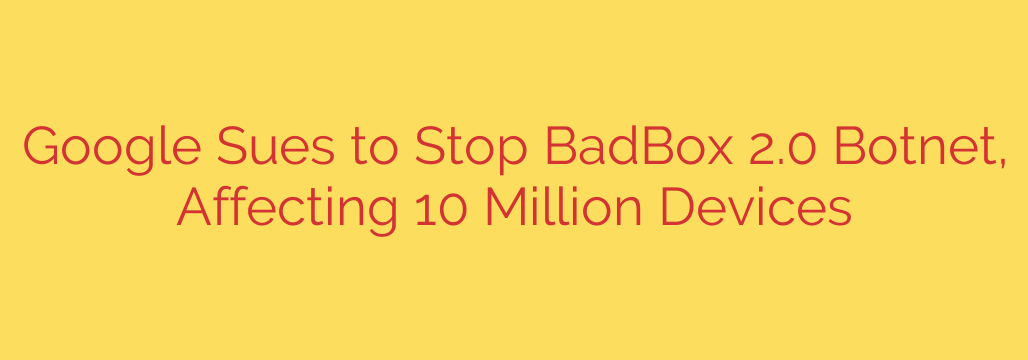
Google Takes on “BadBox” Botnet Infecting Millions of Android Devices
In a significant move to protect users, Google has initiated legal action to dismantle a sophisticated cybercrime operation known as the “BadBox” botnet. This malicious network is believed to have compromised millions of Android devices worldwide by leveraging pre-installed malware on uncertified TV boxes and streaming hardware.
The operation, which has been active since at least 2016, represents a serious and evolving threat to digital security. Here’s what you need to know about the botnet and how to stay safe.
What is the BadBox Botnet?
The BadBox botnet is a network of infected Android devices that are secretly controlled by cybercriminals. These criminals use the compromised devices to carry out a range of illegal activities without the owner’s knowledge or consent.
The core of the operation involves malware that is installed on Android TV boxes before they are even sold to consumers. These infected devices, often marketed as legitimate products through unauthorized online retailers, connect to a command-and-control (C2) server once they are set up and connected to the internet. From there, the attackers can issue commands, install additional malware, and exploit the device’s resources.
At the time of the takedown effort, the botnet had over 70,000 active infections, but evidence suggests the broader network may have impacted as many as 10 million devices globally.
How the Attack Works: From Factory to Fraud
The infection chain is dangerously simple and effective because it bypasses traditional security measures that rely on users downloading malicious apps.
- Pre-Installed Malware: The primary infection vector is malware embedded in the device’s firmware during or after manufacturing. This means the device is compromised straight out of the box.
- Command-and-Control Connection: Upon activation, the device contacts the C2 server, signaling to the attackers that a new device has joined the botnet.
- Secondary Malware Deployment: The attackers then push additional malicious software to the device. A key component identified in this scheme is the notorious “Triada” backdoor, a sophisticated piece of malware that grants attackers extensive control over the infected system.
- Malicious Activities: Once fully compromised, the devices are used for various fraudulent schemes, including:
- Ad Fraud: The botnet generates millions of fake clicks on advertisements, defrauding ad networks and businesses.
- Creating Fake Accounts: The devices are used as residential proxies to create thousands of fraudulent Gmail, YouTube, and other online accounts, which can be used for spam or further scams.
- Residential Proxy Network: The criminals sell access to the infected devices’ IP addresses, allowing other cybercriminals to hide their own malicious traffic and make it appear as if it’s coming from a legitimate home network.
Google’s Takedown and What It Means for Users
Google’s Threat Analysis Group (TAG) and CyberCrime Investigation Group are leading a multi-front battle against this operation. The company has filed a lawsuit and obtained a temporary restraining order to disrupt the botnet’s infrastructure, effectively cutting off communication between the infected devices and the criminals controlling them.
Furthermore, Google is actively working to:
- Take down the domains used by the botnet’s C2 servers.
- Add the malicious domains to Google Safe Browsing to protect users from accessing them.
- Notify affected users through Google Play Protect, which scans Android devices for harmful behavior.
This proactive legal and technical approach is crucial for dismantling large-scale cybercrime rings that operate across international borders.
How to Protect Yourself from Pre-Installed Malware
While Google is tackling the problem at its source, consumer vigilance is the best defense. Here are actionable steps you can take to avoid purchasing a compromised device:
- Buy from Reputable Retailers: Always purchase electronics from well-known, authorized sellers. Be extremely cautious of unfamiliar third-party sellers on online marketplaces, especially if the price seems too good to be true.
- Look for Play Protect Certification: Legitimate Android devices that come with the Google Play Store are certified by Google. You can check the device’s packaging for the Google Play Protect logo. Uncertified devices are far more likely to be insecure or contain pre-installed malware.
- Stick to Known Brands: While lesser-known brands can offer good value, established manufacturers are held to higher security standards. Research any brand you are unfamiliar with before making a purchase.
- Monitor Device Behavior: Keep an eye out for unusual activity, such as apps you didn’t install, excessive data usage, or sluggish performance. These can be signs of a malware infection.
- Keep Your Software Updated: If you have a certified device, always install official software and security updates as soon as they become available. These updates often contain patches for critical security vulnerabilities.
By understanding the threat and making informed purchasing decisions, you can significantly reduce your risk of falling victim to botnets like BadBox.
Source: https://www.bleepingcomputer.com/news/security/google-sues-to-disrupt-badbox-20-botnet-infecting-10-million-devices/








